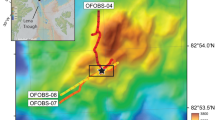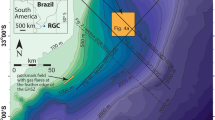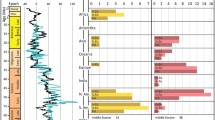Abstract
Continental rifting creates narrow ocean basins, where coastal ocean upwelling results in high biological productivity and organic-rich sedimentation. In addition, topographic gradients promote silicate weathering, which consumes atmospheric CO2 (ref. 1). The carbon flux associated with these processes has led to the suggestion that rifting may cool the atmosphere, leading in some cases to glaciation2 and even a snowball Earth scenario3. Guaymas basin, within the Gulf of California, is a young spreading system where new igneous crust is formed beneath a layer of organic-rich sediment that is 1–2 kmthick. Here we present seismic data from Guaymas basin that image recent, basin-wide magmatic intrusions into sediments; sonar backscatter and seafloor photographs that indicate numerous, broadly distributed chemosynthetic seafloor biological communities, and geochemical analyses of water samples suggesting that the methane that supports these communities is derived from magma-driven thermogenic alteration of sediments. Our results suggest that active shallow magmatism releases carbon from sediments up to 50 km away from the plate boundary. This is a much larger area than the less than 5 km found at unsedimented mid-ocean ridges4, and than previously recognized. We conclude that thick sediments may promote broad magmatism, reducing the efficiency of natural carbon sequestration within young sedimented rifts.
This is a preview of subscription content, access via your institution
Access options
Subscribe to this journal
Receive 12 print issues and online access
$259.00 per year
only $21.58 per issue
Buy this article
- Purchase on Springer Link
- Instant access to full article PDF
Prices may be subject to local taxes which are calculated during checkout



Similar content being viewed by others
References
Lerman, A., Wu, L. & Mackenzie, F. T. CO2 and H2SO4 consumption in weathering and material transport to the ocean, and their role in the global carbon balance. Mar. Chem. 106, 326–350 (2007).
Eyles, N. Glacio-epochs and the supercontinent cycle after ∼3.0Ga: Tectonic boundary conditions for glaciation. Palaeogeogr. Palaeoclimatol. Palaeoecol. 258, 89–129 (2008).
Yannick Donnadieu, Y., Goddéris, Y., Ramstein, G., Anne Nédélec, A. & Meert, J. A ‘snowball Earth’ climate triggered by continental break-up through changes in runoff. Nature 428, 303–307 (2004).
Macdonald, K.C. Mid-ocean ridges: Fine-scale tectonic, volcanic, and hydrothermal processes within the plate boundary zone. Annu. Rev. Earth Planet. Sci. 10, 155–190 (1982).
Stock, J. M. & Lee, J. Do microplates in subduction zones leave a geological record? Tectonics 13, 1472–1487 (1994).
Lizarralde, D. et al. Variation in styles of rifting in the Gulf of California. Nature 448, 466–469 (2007).
Einsele, G. et al. Intrusion of basaltic sills into highly porous sediments, and resulting hydrothermal activity. Nature 283, 441–445 (1980).
Davies, R., Bell, B. R., Cartwright, J. A. & Shoulders, S. Three-dimensional seismic imaging of Paleogene dike-fed submarine volcanoes from the northeast Atlantic margin. Geology 30, 223–226 (2002).
Schrader, H. in Init. Rep. DSDP 64 (eds Curray, J. & Moore, D.) 973–981 (US Government Printing Office, 1982).
Dixon, T. H. et al. New kinematic models for Pacific-North America motion from 3 Ma to present, II, Evidence for a ‘Baja California shear zone’. Geophys. Res. Lett. 26, 1921–1924 (2000).
Einsele, G. Basaltic sill-sediment complexes in young spreading centers: Genesis and significance. Geology 13, 249–252 (1985).
Hansen, D. M & Cartwright, J. A. The three-dimensional geometry and growth of forced folds above saucer-shaped igneous sills. J. Struct. Geol. 28, 1520–1535 (2006).
Svensen, H., Planke, S., Jamtveit, B. & Pedersen, T. Seep carbonate formation controlled by hydrothermal vent complexes: A case study from the Vøring Basin, the Norwegian Sea. Geo-Mar. Lett. 23, 351–358 (2004).
Trude, J., Cartwright, J. A., Davies, R. J. & Smallwood, J. New technique for dating igneous sills. Geology 31, 813–816 (2003).
Galimov, E. M. & Simoneit, B. R. T. in Init. Rep. DSDP 64 (eds Curray, J. & Moore, D.) 781–787 (US Government Printing Office, 1982).
Seewald, J. S., Seyfried, W. E. & Thornton, E. C. Organic-rich sediment alteration; an experimental and theoretical study at elevated temperatures and pressures. Appl. Geochem. 5, 193–209 (1990).
Kastner, M. in Init. Rep. DSDP 64 (eds Curray, J. & Moore, D.) 1143–1158 (US Government Printing Office, 1982).
Schoell, M. Multiple origins of methane in the earth. Chem. Geol. 71, 1–10 (1988).
Whitcar, M. J. Carbon and hydrogen isotope systematics of bacterial formation and oxidation of methane. Chem. Geol. 161, 291–314 (1999).
Glasby, G. P. & Notsu, K. Submarine hydrothermal mineralization in the Okinawa Trough, SW of Japan. Ore Geol. Rev. 23, 299–339 (2003).
Craig, H., Clarke, W. B. & Beg, M. A. Excess 3He in deep water on the East Pacific Rise. Earth Planet. Sci. Lett. 26, 125–132 (1975).
Lupton, J. E. Helium-3 in the Guaymas Basin: Evidence for injection of mantle volatiles in the Gulf of California. J. Geophys. Res. 84, 7446–7452 (1979).
Campbell, A. C., Gieskes, J. M., Lupton, J. E. & Lonsdale, P. F. Manganese geochemistry in the Guaymas Basin, Gulf of California. Geochim. Cosmochim. Acta 52, 345–357 (1988).
Gieskes, I., Kastner, M., Einsele, G., Kelts, K. & Niemitz, J. in Init. Rep. DSDP 64 (eds Curray, J. & Moore, D.) 1159–1168 (US Government Printing Office, 1982).
Thunell, R., Benitez-Nelson, C., Varela, R., Astor, Y. & Muller-Karger, F. Particulate organic carbon fluxes along upwelling-dominated continental margins: Rates and mechanisms. Glob. Biogeochem. Cycles 21, GB1022 (2007).
Sparks, D. W. & Parmentier, E. M. Melt extraction from the mantle beneath spreading centers. Earth Planet. Sci. Lett. 105, 368–377 (1991).
Rabinowicz, M. & Ceuleneer, G. The effect of sloped isotherms on melt migration in the shallow mantle: A physical and numerical model based on observations in the Oman ophiolite. Earth Planet. Sci. Lett. 229, 231–246 (2005).
Maclennan, J., Hulme, T. & Singh, S. C. Thermal models of oceanic crustal accretion: Linking geophysical, geological and petrological observations. Geochem. Geophys. Geosyst. 5, Q02F25 (2004).
Fisher, A. T. & Narasimhan, T. N. Numerical simulations of hydrothermal circulation resulting from basalt intrusion in a buried spreading center. Earth Planet. Sci. Lett. 103, 100–115 (1991).
Simoneit, B. R. T. & Bode, J. R. in Init. Rep. DSDP 64 (eds Curray, J. &Moore, D.) 1303–1305 (US Government Printing Office, 1982).
Acknowledgements
We thank the co-PIs of the PESCADOR experiment, the captains and crew of the R/V Maurice Ewing, R/V New Horizon and R/V Altantis, M. Edwards and the staff of the Hawaii Mapping Research Group for sidescan sonar, D. Fornari, M. Schwartz and A. Fundis for seafloor photography, J. Urban for logistical assistance and A. Gorman for his efforts aboard the R/V New Horizon. This work was financially supported by grants from the US NSF-MARGINS and NSF-IODP programmes.
Author information
Authors and Affiliations
Contributions
D.L. analysed the seismic data, S.A.S. designed and led the seafloor mapping program, J.S.S. designed the fluid chemistry programme and G.P. collected and analysed the fluid samples. D.L. wrote the paper with substantial input from the other authors.
Corresponding author
Ethics declarations
Competing interests
The authors declare no competing financial interests.
Supplementary information
Supplementary Information
Supplementary Information (PDF 2293 kb)
Rights and permissions
About this article
Cite this article
Lizarralde, D., Soule, S., Seewald, J. et al. Carbon release by off-axis magmatism in a young sedimented spreading centre. Nature Geosci 4, 50–54 (2011). https://doi.org/10.1038/ngeo1006
Received:
Accepted:
Published:
Issue Date:
DOI: https://doi.org/10.1038/ngeo1006
This article is cited by
-
Hydrothermal characteristics of the Mienhua submarine volcano in the southernmost Okinawa trough
Marine Geophysical Research (2023)
-
GEYSER: 3D thermo-hydrodynamic reactive transport numerical simulator including porosity and permeability evolution using GPU clusters
Computational Geosciences (2019)
-
Characteristics and Evolution of sill-driven off-axis hydrothermalism in Guaymas Basin – the Ringvent site
Scientific Reports (2019)
-
Seismic evidence for arc segmentation, active magmatic intrusions and syn-rift fault system in the northern Ryukyu volcanic arc
Earth, Planets and Space (2018)
-
Expansive microbial metabolic versatility and biodiversity in dynamic Guaymas Basin hydrothermal sediments
Nature Communications (2018)



